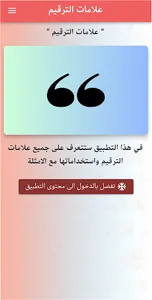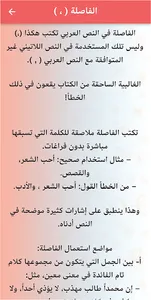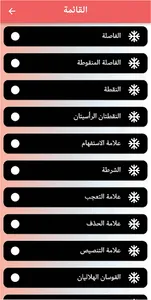Punctuation marks in the Arabic language are placed during or at the end of speech. Among their purposes are organizing writing, facilitating reading, speed of understanding, and good diction, as well as beautifying writing and presenting it well.
The numbering is taken from the (number) of the book, if he wrote it, or from the (number) of the book, meaning its dot; To show its letters, or the meaning of its inscription and decoration.
The Arabs did not know of the punctuation marks in the first centuries of the Hijrah except for the dot, or what takes its place, as a tool for separating sentences, and the dot at the beginning was a circle that was sometimes used abstractly with a dot inside it, and sometimes a line came out of the circle.
The point placed inside or outside it may have been made by the readers; To determine the place on which they stood in reading, and then it became a tradition among copyists to dress up and decorate.
Punctuation is closely related to spelling, as both are an element of clear and sound written expression, and the meaning differs in many linguistic contexts according to the difference in the spelling of letters in a word in terms of error and correctness in writing it. The meaning also differs to the same extent if punctuation marks are used incorrectly.
If the difference in meaning appears clearly between writing the two words in a way that means one of them, such as: (Muhammad was asked) and (Muhammad asked), or (he filled the vessel) and (he filled the vessel); The difference in meaning also appears in the punctuation marks, such as: (the sky is clear) and (the sky is clear?) in the interrogative tone that is shown by the pronunciation.
Contents of the punctuation application:
The comma, also called the separator, and the chole
semicolon
the point
The two vertical points
the police
question mark
Exclamation mark
ellipsis
quotation mark
The semicircular arches
Italic sign
Important notices regarding punctuation
The application includes the uses of punctuation marks in the Arabic language with examples of each punctuation mark.
We are glad you joined the application of punctuation marks
The numbering is taken from the (number) of the book, if he wrote it, or from the (number) of the book, meaning its dot; To show its letters, or the meaning of its inscription and decoration.
The Arabs did not know of the punctuation marks in the first centuries of the Hijrah except for the dot, or what takes its place, as a tool for separating sentences, and the dot at the beginning was a circle that was sometimes used abstractly with a dot inside it, and sometimes a line came out of the circle.
The point placed inside or outside it may have been made by the readers; To determine the place on which they stood in reading, and then it became a tradition among copyists to dress up and decorate.
Punctuation is closely related to spelling, as both are an element of clear and sound written expression, and the meaning differs in many linguistic contexts according to the difference in the spelling of letters in a word in terms of error and correctness in writing it. The meaning also differs to the same extent if punctuation marks are used incorrectly.
If the difference in meaning appears clearly between writing the two words in a way that means one of them, such as: (Muhammad was asked) and (Muhammad asked), or (he filled the vessel) and (he filled the vessel); The difference in meaning also appears in the punctuation marks, such as: (the sky is clear) and (the sky is clear?) in the interrogative tone that is shown by the pronunciation.
Contents of the punctuation application:
The comma, also called the separator, and the chole
semicolon
the point
The two vertical points
the police
question mark
Exclamation mark
ellipsis
quotation mark
The semicircular arches
Italic sign
Important notices regarding punctuation
The application includes the uses of punctuation marks in the Arabic language with examples of each punctuation mark.
We are glad you joined the application of punctuation marks
Show More


